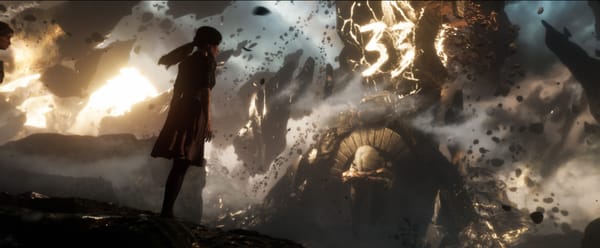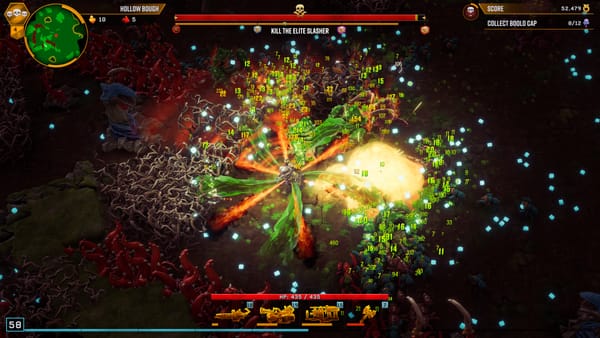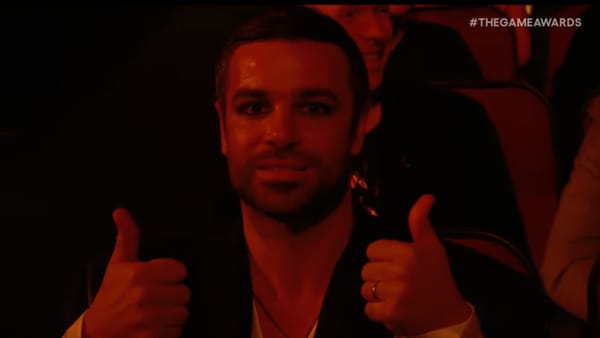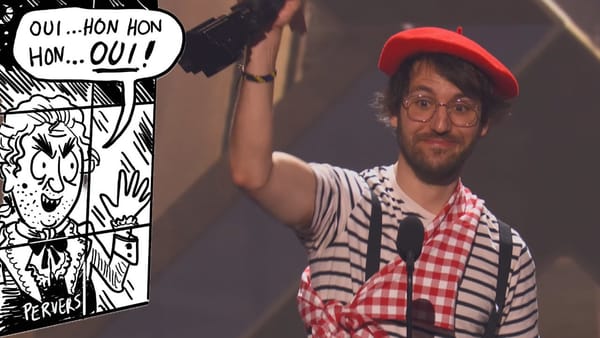#205: Spiking the punch
Hit Points casts its beady critical eye over Street Fighter 6.
Welcome, one and all! Before we get started, a note to free readers. Did you know that a paid subscription to Hit Points costs just £4 a month, and nets you an extra exclusive newsletter every week?
Over the past week or so, paid subs have had a peek behind the curtain at the grimy hidden side of Twitch, and a look at what PlayStation Showcase told us about the current and future state of Sony. Join us, why don’t you. We do have some fun on the other side of the fence.
There is really only one question that needs answering about Street Fighter 6, and one type of person worth writing a review for. If you’re a fighting-game lover, you’ve already bought it; you’ve probably bought a new arcade stick, or fancy leverless controller, or some kind of adaptor to make your trustiest old steed compatible with today’s consoles. Heck, you’re probably playing it right now. On the other hand, if fighting games simply aren’t your thing, nothing I could possibly say would convince you to go and buy Street Fighter 6. Let us speak of it no more.
The only purpose of a Street Fighter 6 review — the only people today’s edition is really meant for — are the people in between. Those that are curious about this series and its genre, who have maybe dipped a toe in over the years, who can see that there is gold in them thar hills but have never been quite able to find it for themselves. People wondering whether this could be the game that finally flings open the door to the magical world of fighting games. You know what? You might just be in luck, to a point.
Street Fighter 6 is, purely on paper, the most approachable, the most easily playable game this series has ever known. In raw, back-of-the-box bullet-point terms, this is self-evidently true. There is a sprawling, 20-plus-hour singleplayer mode called World Tour. There are two alternative control schemes that condense the series’ signature six-button complexity down to a console controller’s face buttons. If you have always wanted to play Street Fighter at a reasonable standard, but haven’t been able to reliably pull off special moves and commit combos to muscle memory, this is the game you have been waiting for. If you have bounced off fighting games of yore because they have been so overwhelmingly geared towards human competition and online play and treat offline single players as a distant afterthought, you’re all set.
If you also expect those things to mean a brilliant videogame, however, you may be disappointed. I love this game, to be clear, but it is not a complete slam-dunk, not an essential purchase for players of every persuasion. It is not quite the fighting game for everyone that I hoped it would be, though it is certainly closer to it than Street Fighter has ever got.
World Tour is big, and long, but I am not sure it is much good, really. You create a character — you can really go wild with this and make something truly grotesque; I made myself, grey hair and big beard, and made myself less grotesque by adding muscles and a defined waist — and trot about Metro City, flitting off around the world as events dictate. You meet Street Fighter characters, all of whom are conveniently willing to take you under their wing, teaching you their various punches and kicks, and a couple of special moves. Over time, as you win fights using their moveset, talk to them, give them gifts and complete odd jobs for them, they’ll give you more moves, Supers and so on.
This is all very silly. But it’s also terrific fun, I must admit, particularly for a series veteran. I have assembled a sort of cut-and-shut Street Fighter character, a walking, punching mixtape of moves that cover just about every situation. My guy currently has Dee Jay’s fireball, Ken’s Shoryuken, Chun-Li’s Spinning Bird Kick and Blanka’s electricity thing. When I meet a new character the first thing I do is consider how their special moves might improve my loadout, or build, or whatever you’d prefer to call it. It’s a nice idea.
The rest of it? Hmm. It is at once very large and terribly lightweight, with lots of to and fro between fights that just aren’t that challenging or even particularly interesting. The writing, of which there is an awful lot, is absolutely abysmal. The story is just nonsense, really, a quest for the contents of a stolen bag that conveniently sends you to Brazil or Jamaica or wherever so you can watch a cutscene, win a fight, tap through some terrible dialogue and come home with a new jumping hard punch, a slightly different fireball, a better anti-air move. You get floods of text messages from NPCs that are written in the style of the worst person you know: one message per sentence, all lower case and no punctuation, the next message in the chain arriving before you’ve had time to finish the previous one. The vibe throughout is daddishly zoomery — ‘a bit Poochy’, as a friend is fond of calling such things.
You collect items you do not need and go shopping for terrible stat-boosting clothes: it represents videogaming’s two clothing genders, streetwear and business casual. You spend skill points to improve your stats, and visit your ‘hangout’, a static image of some weightlifting gear where you can turn day into night, and back into day again, to make quest prompts appear on the map. You buy healing meals from food trucks to top up the health you lose to the endless onslaught of mindless sort-of-random battles that slow your progress constantly, particularly at night.
I completely understand why some reviewers have fallen for this thing. If you are looking at it from within fighting games, and through the lens of Street Fighter specifically, World Tour is a big deal. If you are coming at it from the outside, it is like you asked a machine-learning model to make you a bad Yakuza game using only the PS2 original as a prompt. And this doesn’t even have Michael Madsen and Eliza Dushku to sweeten the pill.
During the pre-release review period, the servers have been offline; World Tour has, therefore, been Street Fighter 6’s main attraction. But I have spent more time playing Arcade Mode like an old duffer, and fiddling around with combo trials and Training mode, than I have in SF6’s headline singleplayer attraction, which I imagine tells you all you need to know. It is aggressively fine, this thing, nothing more, and I have much better things to do with my time.
So, let us move on to the control schemes. I have not even touched the Dynamic control scheme, which automates the Street Fighter experience to such a dramatic extent that all it really expects you to be able to do is load up the game and select a character. You just press a button and it does what it considers, situationally, to be the best move. I think this is wonderful from a pure accessibility perspective, but I am not able to fairly assess it because I already understand Street Fighter, and own slightly too many arcade sticks. It is really not meant for me.
In a way, I feel the same about Modern Controls, which are what you, the hypothetical admirer-from-afar of Street Fighter who has never been able to do dragon punches or combos etc, should use if/when you play SF6. The easiest way to explain Modern Controls is that they turn Street Fighter into Smash Bros. Three face buttons do your light, medium and heavy attacks; the fourth does special moves. D-pad directions dictate the move that comes out. Button combinations, for throws and parries and so on, are on the triggers. Supers — powerful moves that traditionally require a double quarter-circle motion on an arcade stick — are a simple matter of pressing two face buttons at the same time.
It is much, much easier like this, though to me it is distinctly less rewarding. I did not realise until I properly sat down with Modern Controls that a large part of my love for Street Fighter comes from the kinetic pleasure of twirling a joystick and hitting buttons. I may drop 60% of my combos, but the 40% that land more than make up for it. I find that Modern Controls abstract away too much of what made me fall in love with Street Fighter, and with fighting games more broadly.
While they take a lot away, however, Modern Controls add an awful lot too. While they are not for me they could certainly make the difference for you, and people like you, and even people who are completely unlike either of us. Indeed, the Street Fighter tournament scene is a bit fearful of what this pared-back control scheme will mean for high-level competitive play. A number of Japanese players have already pledged to use Modern Controls at launch because they believe the benefits it offers — instant supers and special moves; a general ability to hasten reaction times by the difference, of whatever fraction of a second, between pressing a button and doing a joystick rotation — outweigh its drawbacks (a reduced moveset and fixed damage penalty). That speaks, I think, to Modern Controls’ utility, and their success: when even the best players in the world are thinking they sound like a good time, they are probably worth your attention.
I use Modern quite happily in World Tour, which is so lightweight I don’t consider it a worthwhile use of my joystick inputs. (Besides, navigating a 3D world on an arcade stick designed for 2D games is absolutely vile.) I run around and mash buttons through the dialogue; I switch special moves around and do silly things, knowing that I’ll always have a one-button dragon punch, an instant-access Super and stuff like that. Then, when it’s time to play proper Street Fighter, I reach for my arcade stick. And it is at this point that, for me anyway, Street Fighter 6 finally reveals itself to be magical.
I will put this as simply as I can: this is a very, very good fighting game. Animations are lavish and fluid. Attacks are weighty and impactful. The character designs aren’t as cringingly titsy as in games past, though I am a bit uncomfortable about the Cammy redesign and I’m sure post-launch costume releases will ratchet up the ick factor. As a Street Fighter veteran I love that I can play SF6 like I play SFII, and SFIV, and that it feels almost nothing like SFV, which is a bad videogame.
It has an evolution of Street Fighter III’s parry and a sort of spiritual successor to SFIV’s Focus Attack. It has all the classic SFII characters, some returning favourites from other series entries, and some brilliantly designed new ones. An early favourite is Jamie, a drunken master who, after enough swigs from a flask, lets his hair down and gets a dramatically enhanced moveset. I still mostly play as Ken, though. Please don’t all unsubscribe at once.
At a mechanical level, the biggest change is the Drive meter. This sits underneath your health bar and gives you access to more powerful versions of special moves, as well as system-wide moves like the parry and Drive Impact (a particularly strong technique I’m not sure I like just yet; if you get tagged by one in the corner, it blows through your guard and bounces you off the wall). In previous Street Fighters, and indeed in most fighting games, this sort of gauge is empty at the start of a match, and fills as you land attacks and get hit. In SF6, it is full at the start of each round, depletes when you use its techniques, and refills over time.
Little changes like this can have huge consequences in fighting games, and so it proves here. At the top end of the skill spectrum, it makes for more fast-paced matches, encouraging players onto the front foot the moment the round starts, then guaranteeing mid-match tension once resources start to run dry, and players approach the dangerous Burnout state that triggers when your Drive gauge is empty. At the low end, it means the better player in a skill mismatch has less of an advantage because they’re not getting access to the powerful stuff any faster than their punchbag opponent. There’s still a traditional Super meter, filling over time and persisting between rounds, so the better player still wins out over time. But I like the idea of the designers putting their thumb on the scales like this, to help the less skilled player out a bit. Good stuff.
Even better: the tutorials are great. The World Tour one made me fear the worst — do a jump! Do a backdash! Punch this guy three times! — but elsewhere there are proper introductions to the deeper systems, a full suite of character guides that show you how each fighter should be used, and sets of combo trials, split up by difficulty level, that let you get a handle on each character’s best techniques. As longtime readers will know, Hit Points has long had a stick up its arse about how little fighting games, and Street Fighter in particular, have traditionally cared about new player onboarding. I have no such complaints about SF6, and I am honestly delighted about that.
And that’s about it, really. It is a very good fighting game, this thing, and Street Fighter has never been quite so welcoming, so keen for curious newcomers to better know its magic. But if you’re one of those newcomers, you do need to temper your expectations a little. World Tour is something you’ll likely endure, rather than enjoy. Modern Controls put a lot of power in your hands, but come with a few tradeoffs. Oh and the menus are atrocious, sorry, forgot about that. It’s a big step forward for Street Fighter, and a slightly smaller one for fighting games in general, and the on-ramp is shallower and smoother than ever. If this has convinced you to take the plunge, do let me know; I will happily punch you in the face over the internet. It is one of my favourite things to do and, unlike Street Fighter V, I believe I will be playing this one for a while.
HEROES OF TIME
Our little miniseries of readers’ Zelda memories continues; paid subs have had a couple of absolute crackers in the last couple of editions. I know I’m biased but you free folks really are missing out. Here’s RH.
The lovely thing about living in Hong Kong is that retailers have no respect for release dates: when they get a game, they sell it. I got Breath Of The Wild (and the Switch) two days early; I got Tears Of The Kingdom two days early. (I got the PS5 a day late, but considering we were in the middle of hardcore flight bans and quarantine for all travelers, I consider that a not-so-minor miracle.)
So, Ocarina Of Time was maybe one of the most hyped games ever, with the added air of mystery that games back then had because it was 1998 and video on the internet was relatively rare. And I was, of course, determined to get it early.
A full two weeks ahead of launch I resolved to hit the shops every. Single. Day. And every day I came up empty: searching through a dozen shops in the crowded gaming Mecca of Golden Computer Arcade. On the last few days I’d even started going twice — once early on, and again late in the evening just in case it arrived in between.
And so we get to the day before launch, and still no sign of it. I was about to give up when I heard the sound of a horse galloping.
Hrm. Hang on. Isn’t there a horse in Ocarina Of Time?
Soft piano music kicks in. This isn’t any game I’ve heard before. Can it be...?
I dart around the corner, and there it is: the Legend Of Zelda logo, surrounded by flames, with Link riding Epona under the full moon.
Every time I boot up Ocarina Of Time — and I’ve played it a fair few times — that title screen hits different to any other game, because it takes me back to that very special time and place when the hunt ended and I found myself finally staring at one of the most eagerly awaited, and very best games ever made.
MORE!
Whee, nothing. We covered everything off in yesterday’s paid edition. Love it when this happens.
Right! There we go. Gosh, what a lot of words that was. I hope some of you found it useful but if not, never mind — I love writing about fighting games, and it’s been too long. Have a grand weekend, whatever it has in store, and I’ll see you all next week.





